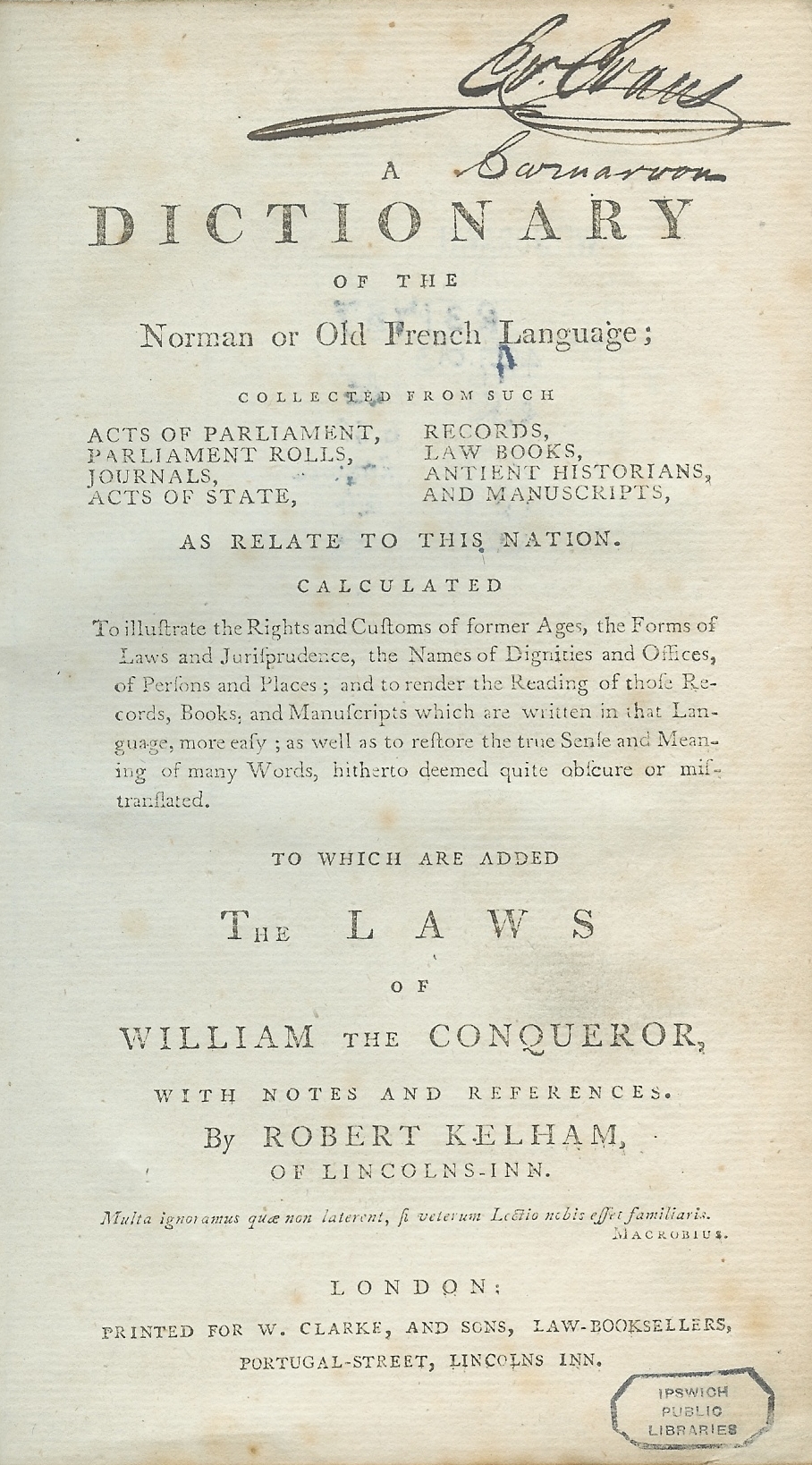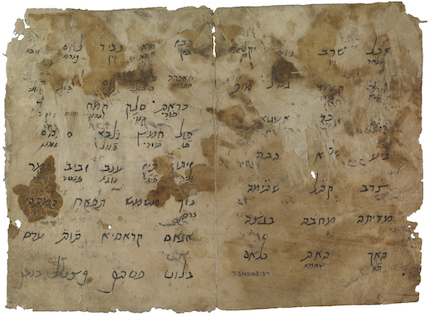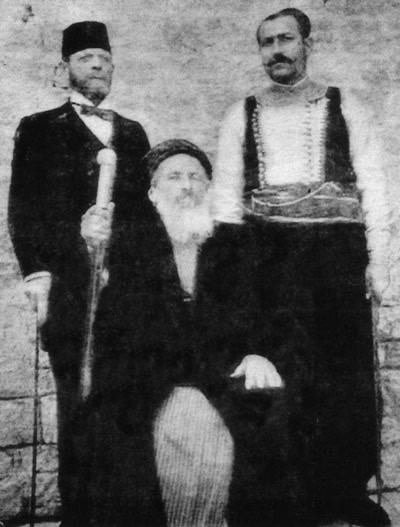|
Jewish Babylonian Aramaic
Jewish Babylonian Aramaic (Aramaic: ) was the form of Middle Aramaic employed by writers in Lower Mesopotamia between the fourth and eleventh centuries. It is most commonly identified with the language of the Babylonian Talmud (which was completed in the seventh century), the Targum Onqelos, and of post-Talmudic ( Gaonic) literature, which are the most important cultural products of Babylonian Jews. The most important epigraphic sources for the dialect are the hundreds of inscriptions on incantation bowls. Classification and type The language was closely related to Eastern Aramaic varieties such as Mandaic. Its original pronunciation is uncertain and has to be reconstructed with the help of these kindred dialects and the reading tradition of the Yemenite Jews, and where available those of the Iraqi, Syrian and Egyptian Jews. The value of the Yemenite reading tradition has been challenged by Matthew Morgenstern. Vocalized Aramaic texts with which Jews are familiar, fr ... [...More Info...] [...Related Items...] OR: [Wikipedia] [Google] [Baidu] |
Linguist List
The LINGUIST List is an online resource for the academic field of linguistics. It was founded by Anthony Aristar in early 1990 at the University of Western Australia, and is used as a reference by the National Science Foundation in the United States. Its main and oldest feature is the premoderated electronic mailing list, with subscribers all over the world. History Between 1991 and 2013, the service was run by Anthony Aristar and Helen Aristar-Dry. In 1991, it moved from Australia to Texas A&M University, and Eastern Michigan University was established as the main editing site. By 1994, there were over 5,000 subscribers. From 14 October through 6 November 1996, it held its first on-line conference, ''Geometric and Thematic Structure in Binding'', devoted to the Binding Theory and opened by the keynote address by Howard Lasnik. LINGUIST List moved from Texas A&M to its own site in 1997. Wayne State University in Michigan was established as the second editing site in 1998, bu ... [...More Info...] [...Related Items...] OR: [Wikipedia] [Google] [Baidu] |
Incantation Bowl
Incantation bowls are a form of Apotropaic magic, protective magic found in what is now Iraq and Iran. Produced in the Middle East during late antiquity from the sixth to eighth centuries, particularly in Upper Mesopotamia and Syria (region), Syria, the bowls were usually inscribed in a spiral, beginning from the rim and moving toward the center. Most are inscribed in Jewish Babylonian Aramaic. Scholar John Charles Arnold states the bowls were used as such: "When placed upside down under each corner of a house, demons would follow the inscribed charms that spiraled from the outer rim inward, only to be caught in the center." They were commonly placed under the threshold, courtyards, in the corner of the homes of the recently deceased and in cemetery, cemeteries. The majority of Mesopotamia's population were either Christians, Christian, Manichaeism, Manichaean, Mandaeans, Mandaean, Jewish, or adherents of the Ancient Mesopotamian religion, ancient Babylonian religion, all of wh ... [...More Info...] [...Related Items...] OR: [Wikipedia] [Google] [Baidu] |
Judeo-Aramaic Languages
The Judaeo-Aramaic languages are those varieties of Aramaic and Neo-Aramaic languages used by Jewish communities. Early use Aramaic, like Hebrew, is a Northwest Semitic language, and the two share many features. From the 7th century BCE, Aramaic became the lingua franca of the Middle East. It became the language of diplomacy and trade, but it was not yet used by ordinary Hebrews. As described in 2 Kings , the messengers of Hezekiah, king of Judah, demand to negotiate with ambassadors in Aramaic rather than Hebrew (''yehudit'', literally "Judean" or "Judahite") so that the common people would not understand. Gradual adoption During the 6th century BCE, the Babylonian captivity brought the working language of Mesopotamia much more into the daily life of ordinary Jews. Around 500 BCE, Darius I of Persia proclaimed that Aramaic would be the official language for the western half of his empire, and the Eastern Aramaic dialect of Babylon became the official standard. In 1955, Ri ... [...More Info...] [...Related Items...] OR: [Wikipedia] [Google] [Baidu] |
Modern Hebrew
Modern Hebrew (, or ), also known as Israeli Hebrew or simply Hebrew, is the Standard language, standard form of the Hebrew language spoken today. It is the only surviving Canaanite language, as well as one of the List of languages by first written account, oldest languages still spoken as a native language, native language, on account of Hebrew being attested since the 2nd millennium BC. It uses the Hebrew Alphabet, an Abjad, abjad script written from right-to-left. The current standard was Codification (linguistics), codified as part of the revival of Hebrew in the late 19th and early 20th centuries, and now serves as the Official language, sole official and national language of the State of Israel, where it is Languages of Israel, predominantly spoken by over 9 million people. Thus, Modern Hebrew is near universally regarded as the most successful instance of language revitalization in history. A Northwest Semitic language within the Afroasiatic languages, Afroasiatic langu ... [...More Info...] [...Related Items...] OR: [Wikipedia] [Google] [Baidu] |
Judeo-Arabic Languages
Judeo-Arabic (; ; ) sometimes referred as Sharh, are a group of different ethnolects within the branches of the Arabic language used by jewish communities. Although Jewish use of Arabic, which predates Islam, has been in some ways distinct from its use by other religious communities, it is not a uniform linguistic entity. Varieties of Arabic formerly spoken by Jews throughout the Arab world have been, in modern times, classified as distinct ethnolects. Under the ISO 639 international standard for language codes, Judeo-Arabic is classified as a macrolanguage under the code jrb, encompassing four languages: Judeo-Moroccan Arabic (aju), Judeo-Yemeni Arabic (jye), Judeo-Egyptian Arabic (yhd), and Judeo-Tripolitanian Arabic (yud). Judeo-Arabic, particularly in its later forms, contains distinctive features and elements of Hebrew and Aramaic. Many significant Jewish works, including a number of religious writings by Saadia Gaon, Maimonides and Judah Halevi, were originall ... [...More Info...] [...Related Items...] OR: [Wikipedia] [Google] [Baidu] |
Law French
Law French () is an archaic language originally based on Anglo-Norman, but increasingly influenced by Parisian French and, later, English. It was used in the law courts of England from the 13th century. Its use continued for several centuries in the courts of England and Wales and Ireland. Although Law French as a narrative legal language is obsolete, many individual Law French terms continue to be used by lawyers and judges in common law jurisdictions. History The earliest known documents in which 'French', i.e. Anglo-Norman, is used for discourse on English law date from the third quarter of the thirteenth century, and include two particular documents. The first is the 1258 '' Provisions of Oxford'', consisting of the terms of oaths sworn by the 24 magnates appointed to rectify abuses in the rule of King Henry III, together with summaries of their rulings. The second is the ''Casus Placitorum'' (), a collection of legal maxims, rules and brief narratives of cases. In t ... [...More Info...] [...Related Items...] OR: [Wikipedia] [Google] [Baidu] |
Siddur
A siddur ( ''sīddūr'', ; plural siddurim ) is a Jewish prayer book containing a set order of daily prayers. The word comes from the Hebrew root , meaning 'order.' Other terms for prayer books are ''tefillot'' () among Sephardi Jews, ''tefillah'' among German Jews, and ''tiklāl'' () among Yemenite Jews. History The earliest parts of Jewish prayer books are the '' Shema Yisrael'' ("Hear O Israel") (Deuteronomy 6:4 ''et seq'') and the Priestly Blessing ( Numbers 6:24-26), which are in the Torah. A set of eighteen (currently nineteen) blessings called the ''Shemoneh Esreh'' or the ''Amidah'' (Hebrew, "standing rayer), is traditionally ascribed to the Great Assembly in the time of Ezra, at the end of the biblical period. The name ''Shemoneh Esreh'', literally "eighteen", is a historical anachronism, since it now contains nineteen blessings. It was only near the end of the Second Temple period that the eighteen prayers of the weekday Amidah became standardized. Even at ... [...More Info...] [...Related Items...] OR: [Wikipedia] [Google] [Baidu] |
Tanakh
The Hebrew Bible or Tanakh (;"Tanach" . ''''. ; ; or ), also known in Hebrew as (; ), is the canonical collection of scriptures, comprising the (the five Books of Moses), the |
Matthew Morgenstern
Matthew Morgenstern, also known as Moshe Morgenstern (; born 1968 in London, United Kingdom), is an Israeli linguist and religious studies scholar known for his work on Eastern Aramaic languages, especially Mandaic. He is currently Full Professor in the Department of Hebrew Language and Semitic Linguistics at Tel Aviv University. Education Matthew Morgenstern was born in London in 1968. He obtained his B.A. degree in Social and Political Science from the University of Cambridge in 1990. In 1992, he received his Master of Arts degree in Aramaic Bible Translation from the Department of Hebrew and Jewish Studies at University College London. In the same year, he immigrated to Israel. In Israel, he studied at the Hebrew University of Jerusalem, where he first obtained a Master of Arts degree in Hebrew Language in 1996. As a masters student, he was part of a research group that worked on the Dead Sea Scrolls. Morgenstern continued his doctoral studies at the Hebrew University of Jerusa ... [...More Info...] [...Related Items...] OR: [Wikipedia] [Google] [Baidu] |
Yemenite Hebrew
Yemenite Hebrew (), also referred to as Temani Hebrew, is the pronunciation system for Hebrew language, Hebrew traditionally used by Yemenite Jews. Yemenite Hebrew has been studied by language scholars, many of whom believe it retains older phonetic and grammatical features lost elsewhere. Yemenite speakers of Hebrew have garnered considerable praise from language purists because of their use of grammatical features from classical Hebrew. Some scholars believe that its phonology was heavily influenced by spoken Yemeni Arabic. Other scholars, including Yosef Qafih and Abraham Isaac Kook, hold the view that Yemenite Arabic did not influence Yemenite Hebrew, as this type of Arabic was also spoken by Yemenite Jews and is distinct from the liturgical and conversational Hebrew of the communities. Among other things, Qafih noted that the Yemenite Jews spoke Arabic with a distinct Jewish flavor, inclusive of pronouncing many Arabic words with vowels foreign to the Arabic language, e.g., th ... [...More Info...] [...Related Items...] OR: [Wikipedia] [Google] [Baidu] |
History Of The Jews In Egypt
The history of the Jews in Egypt goes back to ancient times. Egyptian Jews or Jewish Egyptians refer to the Jewish community in Egypt who mainly consisted of Egyptian Arabic-speaking Rabbanites and Karaites. Though Egypt had its own community of Egyptian Jews, after the Jewish expulsion from Spain more Sephardi and Karaite Jews began to migrate to Egypt, and then their numbers increased significantly with the growth of trading prospects after the opening of the Suez Canal in 1869. As a result, Jews from many territories of the Ottoman Empire as well as Italy and Greece started to settle in the main cities of Egypt, where they thrived (see Mutammasirun). The Ashkenazi community, mainly confined to Cairo's Darb al-Barabira quarter, began to arrive in the aftermath of the waves of pogroms that hit Europe in the latter part of the 19th century. In the aftermath of the 1948 Palestine War, the 1954 Lavon Affair, and the 1956 Suez War, Jewish (estimated at between 75,000 and 80,0 ... [...More Info...] [...Related Items...] OR: [Wikipedia] [Google] [Baidu] |
Syrian Jews
Syrian Jews ( ''Yehudey Surya'', ''al-Yahūd as-Sūriyyūn'', colloquially called SYs in the United States) are Jews who live in the region of the modern state of Syria, and their descendants born outside Syria. Syrian Jews derive their origin from two groups: from the Jews who inhabited the region of today's Syria from History of ancient Israel and Judah, ancient times (known as Musta'arabi Jews), and sometimes classified as Mizrahi Jews (''Mizrahi'' is a generic term for the Jews with an extended history in Asia or North Africa); and from the Sephardi Jews (referring to Jews with an extended history in the Iberian Peninsula, i.e. Spain and Portugal) who fled to Syria after the Alhambra Decree forced the expulsion of the Jews from Spain in 1492. There were large communities in Aleppo ("Halabi Jews", ''Halab'' is "Aleppo" in Arabic) and Damascus ("Shami Jews") for centuries, and a smaller community in Qamishli on the Turkish border near Nusaybin. In the first half of the 20th ce ... [...More Info...] [...Related Items...] OR: [Wikipedia] [Google] [Baidu] |







